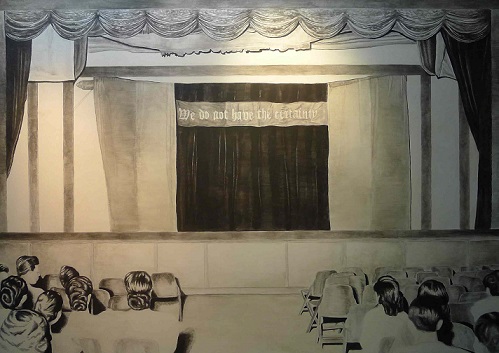藝評
非暴力態度!(A Non-violent Attitude!)
約翰百德 (John BATTEN)
at 4:39pm on 21st March 2016





Captions:
1. Statue of Chino Roces in front of Mendiola Bridge, Manila.
2. Detail of large-scale 'His Only Son' installation (in homage of Christ) at Art Fair Philippines by Philippine artist Daniel de la Cruz.
3. Winner Jumalon, 'Llevame a la Luna' ('Fly Me to the Moon'), oil on canvas, 122x107cm, 2016 (Courtesy of Yavuz Gallery, Singapore).
4. Allan Balisi, 'Aspiring Act Alone', oil on gessoed canvas, 162.6x243.8cm, 2015 (courtesy of Silverlens, Manila).
5. Installation view of Romina Diaz's photography 'Stagnant Energies' photography exhibition at Finale Art File, Chino Roces Avenue, Makati, Manila.
All photos: John Batten
(Please scroll down for English version.)
當你讀到這篇時,香港的媒體將會有很多關於Art Basel Hong Kong的新聞,這是全球最大貿易展覽公司在我城舉辦的年度藝展,盛事的終極擁有人是瑞士城市巴塞爾。現時,大部份世界主要城市有舉辦藝展,上月我便到了馬尼拉參與Art Fair Philippines。規模而言,菲律賓藝術展較香港細小,但同樣引人注目,而且吸引了菲律賓當地最優秀的畫廊參展,出席的還有來自香港、新加坡和馬來西亞的代表。這個藝展自四年前便以馬尼拉馬卡堤中央商業區的多層停車場為場地,在三個樓層中加入臨時安裝的冷氣、畫廊藝術品的攤位間隔等。
奇諾羅塞斯大道就在馬卡堤近郊不遠處,這裡前稱Pasong Tamo,是一個為畫廊提供大型工業用空間的貨倉區,與香港的黃竹坑有點相似,因為租金較便宜和空間較大而備受畫廊和設計師傢俱店青睞。大道沿途有幾家馬尼拉知名度最高的商業畫廊;Silverlens和The Drawing Room均會來港參與Art Basel Hong Kong。
傳統上,這區是報章辦公室、電台和電視台的所在地,至今仍然是一個代表藝術和表達自由的地點。華金.「奇諾」.羅塞斯曾是《馬尼拉時報》的出版人,他在1988年離世時,馬卡堤市議會數天後把道路更名為奇諾羅塞斯大道以作紀念。
當我在馬尼拉時,該國已在準備慶祝桑托斯大道人民力量推翻馬可斯獨裁統治30週年。桑托斯大道是一條貫穿馬尼拉的擠迫長街,途經軍事基地和國家警察總部。
馬可斯在1972年已完成了最多兩個4年的總統任期,根據憲法,他應讓國家舉行新總統大選。然而,馬可斯宣佈執行軍事法,藉口是「法治情況每況愈下」,並取消大選。此後14年,他以總統身份和獨裁方式操控憲法及統治菲律賓,他的政府貪污情況越來越嚴重,並隨意地扣留、虐待和謀殺反對者。
馬可斯反對者及民粹領袖貝尼格諾.阿奎諾於1983年在馬尼拉機場被殺,激起了國際間的憤怒,也在菲律賓引發了多場示威。馬可斯的地位變得岌岌可危,他被迫宣報於1986年初舉行大選。他當時的對手是貝尼格諾.阿基諾的遺孀阿奎諾夫人。在選舉舞弊和操縱選票相繼出現下,示威升級,最終軍隊發動政變推翻馬可斯,但卻被支持馬可斯的軍隊抵抗。最初支持馬可斯但後來成為反對者的天主教教會呼籲市民現身桑托斯大道,站在反對軍的軍事基地之間,齊聲要求馬可斯下台。結果,有上百萬人走到桑托斯大道街上,並和平地調解了任何與敵對軍隊間可能出現的軍事行動。
1986年2月25日,馬可斯帶著家人和一群支持者從馬尼拉逃亡,翌日抵達夏威夷。
位於總統府附近的門迪奧拉橋,是馬可斯獨裁統治期間的一個示威場地。橋上顯眼的位置竪立了奇諾.羅塞斯的雕像(見下圖)。雕像下面有一塊牌匾,上面寫著:「在這條歷史大橋上,無數菲律賓人在爭取自由、真理和公義的示威中發聲。」奇諾.羅塞斯生前是一位「新聞出版人、民權領袖和關心社會的市民,他站在這片土地上,是提出非暴力鬥爭的中心人物,他與其他不同訴求的團體和顯赫的獨立人士,透過『街頭國會』把自由與公義的主張直接帶給人民。奇諾在世時,想法清楚簡單:政府必須聆聽人民的聲音,因為政府是為人民而設,而不應與民為敵。」 牌匾的下款瀟灑地簽上了「感恩的國家」,日期為1989年6月24日。
當我告訴經常光顧茶餐廳的職員,我剛剛到訪過馬尼拉,她問我那裡會不會有危險,然後做了一個開槍的手勢。2010年發生的馬尼拉人質危機奪去了不少香港人的性命,影響了我們對這個充滿熱情國家的看法。正如最近在農曆年發生的旺角暴 力事件並不反映所有香港人的態度,馬尼拉的情況也一樣。
香港《基本法》是一套迷你憲制,確保香港擁言論、集會等很多自由。然而,要合法享受這些自由,便必須遵循憲制與法定規範、抱持非暴力態度。否則,就如馬可斯一樣,鎮壓便有其合理理由。菲律賓例子具有深遠的影響:1986年馬尼拉街頭上的非暴力運動,啟發了1989年中國天安門的抗議,也令柏林圍牆倒下,打破了東西歐的隔閡。非暴力的抗爭終會獲勝。
原文刊於《明報周刊》,2016年3月12日。
A Non-violent Attitude!
by John Batten
As you read this, Hong Kong’s media will be full of news about Art Basel Hong Kong – the city’s annual art fair run by the world’s biggest trade exhibition company, whose ultimate owner is the Swiss city of Basel. Art fairs are now held in most major cities and last month I visited Art Fair Philippines in Manila. It is a smaller art fair than Hong Kong’s but equally stimulating and attracts the best Philippine galleries and some from Hong Kong, Singapore and Malaysia. Since starting four years ago, the art fair has used a centrally located multi-level carpark in Manila’s Makati central business district, temporarily installing air-conditioning and booth partitioning for gallery artwork and larger sponsored installation pieces spread over three floors.
Not far away on the outskirts of Makati is Chino Roces Avenue, formerly known as Pasong Tamo, a warehouse area that offers large industrial spaces for galleries. It is similar to Hong Kong’s Wong Chuk Hang where art galleries and designer furniture shops are attracted by lower rents and larger spaces. Along this road are some of Manila’s highest profile commercial galleries; Silverlens and The Drawing Room will both participate at Art Basel Hong Kong.
This area traditionally housed newspaper offices, radio and television stations – it still remains a place of artistic freedom of expression. Joaquin ‘Chino’ Roces was formerly publisher of the Manila Times newspaper and the Makati City Council named Chino Roces Avenue in his honour a few days after his death in 1988.
While I was in Manila preparations were being made for the 30th anniversary of the EDSA People Power overthrow of the Marcos dictatorship. EDSA is a long, crowded road that runs through Manila and crucially past military bases and the National Police Headquarters.
Ferdinand Marcos had by 1972 been President for his maximum two 4-year terms and according to the constitution should have allowed an election to vote for a new President. Instead, Marcos declared martial law using “a deteriorating law and order situation” and cancelled the elections. He then ruled as a dictator under a manipulated constitution as President for the next 14 years and his administration became increasingly corrupt and arbitrarily detained, tortured and murdered his political opponents.
The assassination of the populist leader and Marcos opponent Benigno Aquino in 1983 at Manila Airport triggered international outrage and protests in the Philippines. Marcos’ position became increasingly untenable and he was forced to call elections in early 1986. He ran against Corazon Aquino, Benigno’s widow. Amidst election fraud and vote rigging, protests escalated and a military coup to overthrow Marcos was mounted - but opposed by troops loyal to Marcos. The Catholic Church, an early Marcos ally but later opponent, called on people to stand between the opposing troops’ military bases on EDSA while demanding Marcos to resign. A million people spread along EDSA and peacefully interceded in any possible military action between the opposing army troops.
On 25 February 1986, Marcos and his family and a group of supporters fled Manila to reach Hawaii a day later.
One of the sites of protests during the Marcos dictatorship was Mendiola Bridge, near the Presidential residence. Prominently erected in front of the bridge is a statue of Chino Roces (illustrated below). A plaque explains that, “On this historic bridge, countless Filipinos raised their voices in protest fighting for freedom, truth and justice.” Chino Roces was a “journalist-publisher, civic leader and concerned citizen (who) stood his ground and was a central figure in raising a non-violent struggle as he, together with various cause-orientated groups and prominent individuals, took the cause of freedom and justice directly to the people through the ‘Parliament of the Streets’. During his lifetime, Chino was clear and simple: government must listen to the people for government is for the people, and cannot be used against the people.” It was poignantly signed, “From a grateful nation.” Dated 24 June 1989.
When I told a staff member at my local chan cha teng that I had just visited Manila, she asked if it was dangerous, and made a shooting gun gesture. The appalling Manila hostage crisis when Hong Kong tourists lost their lives in 2010 has coloured our view of this passionate country. And just as the recent New Year violence in Mong Kok does not reflect the attitude of all Hong Kong people, so too in Manila.
Hong Kong’s mini-constitution, the Basic Law, guarantees Hong Kong many freedoms…of speech, of assembly etc. The legitimacy to enjoy these freedoms is however within constitutional and legal parameters and a non-violent attitude. Otherwise, like Marcos did, suppression can easily be justified. The Philippine example is compelling: the non-violence seen on Manila’s streets in 1986 inspired the 1989 Tiananmen protests in China and the fall of the Berlin Wall and opening up of Eastern Europe. Non-violent opposition eventually prevails.
Originally published in Ming Pao Weekly, 12 March 2016.
